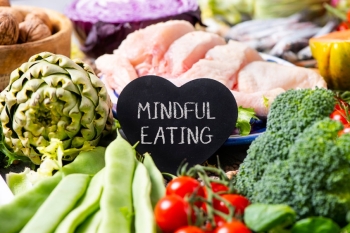
Mindful Eating
Food is not only a way to nourish your body, but has also become a way to socialize, cope, and entertain. Society has placed more attention on what you eat, how much you eat, and when you eat, than on how you eat. This missing piece of awareness diminishes your experience of eating, Lack of attention to how you eat can facilitate an unhealthy relationship to food. A healthy relationship with food is when eating is effortless. First, you notice you are hungry or want to eat, then you chose the food/meal you crave, then you eat and stop when you are full or satiated. A healthy relationship is even when you eat socially or for pleasure. For example, eating a slice of cake because it tastes good and makes you happy. An unhealthy relationship to food can be obsessive, compulsive, and have a negative impact on your mental, emotional, and physical health. An unhealthy relationship consists of negative self-talk and shame, avoiding social situations because of food, and spending endless time during the day thinking about food. Mindful eating focuses on reconnecting yourself to the sensations of eating, which allows us to enjoy food, to be aware of hunger, fullness, thoughts, and feelings of actually eating and being around food. We often eat without taking the time to taste our food or become aware of the emotional and bodily sensations we experience when we eat. Mindful eating can help create a more positive and healthy relationship with food, where we eat to enjoy the taste and nourish our bodies. Here are some ways to practice mindful eating.
Eat slower
We have become disconnected to food that we often do not pay attention to how we are eating. Consciously try to slow your eating, paying attention to how the food tastes and how it feels. Slowing down your eating will help you chew your food better and be able to tell when you are full. Try chewing 20 times before you swallow. Notice the flavors when you are chewing. Is it savory or sweet? Also notice how the food feels as you chew longer. How does the texture change? How about the taste? Does the flavor change? What is your favorite part about the flavor? Tuning into these types of questions, will help you concentrate on eating. In addition to noticing the physical experience of food, also tune into your feelings. How do you feel when you chew for 20 times? Do you feel anxious or relaxed? Do you feel happy or sad? How does it feel when you chewed slower? Is it a pleasant experience or a stressful experience? Compare these feelings with different food. How does it feel eating meat? How is it different from when you eat vegetables? Beans? As your body absorbs energy sources people often do experience emotional shifts. Can you help a person tune in. also as they chew longer can you help a person tune into why they are eating the food and what the emotions are connect emotions to the body Some people may find this uncomfortable and frustrating. You can practice eating slower by using chopsticks or using your non-dominant hand. Set a timer for 20 minutes and take the entire time to eat your meal.
Eat in silence
Turn off all distractions, so you can focus solely on eating. When we watch TV or look at our phones we become more focused on what we are watching than on the food we are eating. Eating in silence will make you become more in tune with the tastes and experience of the food. When you are used to eating with people or the TV, anxiety can come up that makes eating in silence difficult. Try to record every thought and feeling that comes into your brain when you are eating in silence. This allows you the space to explore your relationship with food. What’s different eating in silence than my usual eating experience? Do you usually eat for functionality? Or do you want eating to be a pleasurable experience?
Pay attention to hunger
When you want to eat, is it because you are hungry, it’s dinner time or you are feeling anxious, bored sad or happy? Start to notice what your hunger feels like. Is your stomach growling? Are you tired? Are you feeling lightheaded? What is your body craving? These bodily cues can help shift your attention from emotional signals to physical sensations of hunger. Additionally, once you start eating, notice when you are full. We tend to eat based on our minds, rather than our bodies. Ask yourself: what are your emotional triggers for eating? Is it stress or anxiety? Notice what you feel in your body when you are hungry. When do you have more cravings? Check in with yourself during all times of the day. Are you more hungry in the morning when you wake up or at night. Keep a journal and write down each experience you have when you want to eat and when you eat. Write down the time, your mood, thoughts, and feelings. Do this everyday and then at the end of the week you can track your daily patterns. Video tape- compare and contrast emotional content, who were you talking to-- before and after tip. Often we eat socially, and not necessarily when we are hungry. For example, a lot of families eat dinner together. You may not be hungry, but since everyone else is eating you chose this time to eat. Is this pattern of eating what you want? Or do you want a different experience?
Use all of your senses to explore the food: smell, sight, taste.
Instead of just eating immediately when you get your food, take a second to pay attention to the sensations of your senses. What color is the food? What does it smell like? Take a small bite and close your eyes. How does it taste? Is it sweet? Salty? Savory? As you start to chew, keep aware of how the taste is changing or staying the same. How does your body respond once you swallow the food? What do you notice in your body? What do you feel? This exercise allows you to be completely connected to the food. Do you enjoy what you’re eating? Mindful eating helps you discover what meals you enjoy because you like the taste or like how the food makes your body feel. For example, eating chicken breast with vegetables may be less flavorful than BBQ rips with corn bread, but it may make your body feel more nourished while the ribs will make you feel warm and comfy. Different meals can make your body feel a variety of ways! Learning which foods have each effect is a helpful awareness to have when you decide what to eat.
Do not judge yourself
We often have “rules” for food, especially within the prominent diet culture of our society. Become aware of the rigid rules you may have around food. There are a million different diet theories out there and each have a different belief on what foods are better than others. Therefore, when people jump from diet to diet it may become exhausting to try to live by all of those “rules.” Many people experience shame if they eat a couple doughnuts. This shame can create negative self thoughts such as “why did you eat that? You should not have eaten that. You are bad!” Negative self thoughts diminish the way you feel about yourself and you should judge themselves because of what they eat, especially if you enjoyed eating it! Become aware of what “should” thoughts come into your mind when you eat. Tell yourself that there is no “good” or “bad” food, and that you deserve to enjoy your food. When these negative thoughts come up in your head, notice them, and quickly ask yourself “why do i feel bad?” Then answer that question. “I feel bad because…” Once you answer that question, ask yourself “why do I want to eat this? I want to eat this because…” Maybe you are craving something sweet and that’s okay! When you deprive yourself of foods that you crave, this deprivation turns into punishment. It is important to eat foods that make you feel good. Becoming mindful of your cravings, hunger, and eating patterns than you become more in tune with your body and yourself.
Mindful eating takes time and practice. At first, it may create some anxiety and discomfort because it is new and different. There is no finish line or concrete goal but instead just the acquisition of skills that can create a more enjoyable relationship to eating. This is not to say that mindful eating is the only and best way to eat, but for those who want to grow a better awareness around eating than it is a helpful approach to do so.
The Center for Growth has therapists that specialize in eating disorder treatment.
The Center for Growth has therapy offices in multiple state. We offer inperson as well as virtual appointments.
The Center for Growth Therapy Offices in PA, NJ, VA, RI, NM
- Ocean City Therapy Office
360 West Ave, Floor 1, Ocean City, NJ 08226 - Mechanicsville Therapy Office
9044 Mann Drive, Mechanicsville Virginia, 23116 - Providence Therapy Office
173 Waterman St. Providence, RI 02906 - Society Hill Therapy Office
233 S. 6th Street, C-33, Philadelphia PA 19106 - Art Museum / Fairmount Therapy Office
2401 Pennsylvania Ave, Suite 1a2, Philadelphia PA 19130 - Santa Fe Therapy Office, 2204 B Brothers Road, Santa Fe, New Mexico, 87505
- Telemedicine: We have therapists who are licensed to work in Delaware, Connecticut, Florida, Georgia, New Jersey, New Mexico, Pennsylvania, Rhode Island, and Virginia.



















